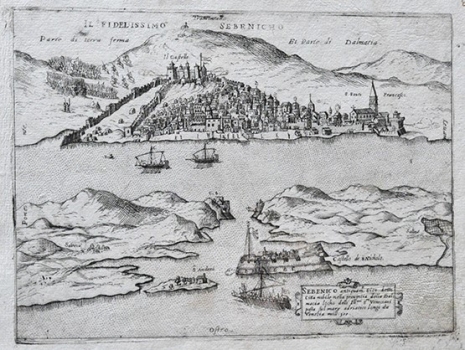CAMOCIO, GIOVANNI FRANCESCO: VIEW OF ŠIBENIK
Inventory number 270
Original title: Sebenico antiquam[ent]e. Sico detto Citta nobile nella prouincia della Dallmacia locho delli Ill[ustrissi]mi S[igno]ri Veneciani posta sul mare adriatico longhi da Venecia mill[ia] 300
Publishing year: 1571
Place of publishing and publisher: Venezia
Format: 16,5 x 22 cm
Technique: Copper engraving
This view shows the town of Šibenik as it was when originally drawn by the Šibenik native Martin Rota Kolunić for the famous isolario published, in 1571, by Francesco Camoco in his isolario entitled “Isole famose porti, fortezze, e terre maritime sottoposte della serenissima Signoria di Venetia, ad altri Principi Christiani, et al signor Turco, nuoamete poste in luce” The view of Šibenik made by Kolunić is considered to be the most faithful representation of some Croatian town made during the Renaissance period. In the foreground, artfully drawn castle of St. Nicolas and two smaller bastions guarding the entrance into the Šibenik channel are shown. The map image is dominated by the fortress on top of a hill above the town (Castelo). From the fortress two defense walls, inner and outer, descend towards the sea. It seems most likely that the plots of ground enclosed by the walls that contain lesser number of built structures were used as cultivable land (the fertile inland area was in Turkish possession!). Some characteristic Šibenik palaces and the cathedral are shown. The town extends to the east up to the monastery of St. Francis. By highlighting Šibenik’s topographic position on the elevation offering good oversight on the surrounding area, as well its castles, ramparts and sea bastions, the author created impression of great power of the fortifications and impregnability of Šibenik, being that that town one of the key strategic points in the defense from the Turks.
CAMOCIO, GIOVANNI FRANCESCO
CAMOCIO, GIOVANNI FRANCESCO (Camocius, Camotio, Cametti, Gioan, Joan Francisco) a Venetian cartographer, publisher and merchant whose most productive period was between 1558 and 1575. He obtained his bookseller's and publisher's licence in Venice in 1552, marked Al segno della Pyramide. His copper-plate engraving workshop produced maps and vedute that as a publisher he was signing with apresso or apud G. F. Camocio cum privilegio. The most fertile period of his artistic production, between the 1550s and the 1570s, was also the peak of the isolarii (depictions of islands) period, especially in Italy. These are detailed, practical, perspective depictions of certain cities and ports, created predominantly in a large-scale copper-plate engraving technique. Unlike earlier portulan charts, these depictions of the maritime area and the inland of the islands were largely based on field work. Along with G. Rosaccio, G. Franco and S. Pinargenti, Camocio was the most significant representative of the tradition. His interest lay on the eastern Adriatic coast where he had his informants and topographers, so he created several maps of the Croatian lands. His most famous works are Lombardija Atlantic from 1560, which he created with Forlani, Dalmatia i Friuli from 1563, Isole Famose from 1563 and 1564, Grčka, Italija i Napulj from 1566, Venecija from 1571 and Europa, published in 1579. His copper plates were passed on to Donato Bertelli. Copper plates were, at the time, passed on, inherited, exchanged and traded, and the information they carried was also often exchanged among cartographers and publishers. His most famous maps of our (Croatian) territories are Novo dissegno della Dalmatia et Crovatia from 1566, Istra from 1569, and he also authored the isolario or atlas Isole famose, porti, fortezze e terre maritimme… from 1571 and 1574, comprising a large number of maps of the Croatian territories, although he did not author all of the maps contained within it. Almost twenty of his maps are depictions of the Croatian Littoral or port vedute, but he only signed some of them, which are most likely the ones he personally refined or updated. His maps of Dalmatia and Istria show that he had access to higher quality topographic templates or data only for some regions, such as Coppo’s map of Istria from 1525. He also published the works by local cartographers, Natalo Bonifaci and Martino Rota, from where he clearly sourced the cartographic information for his own works. He was obviously very skilled in selecting the information he would use, as he tried to correct some frequently repeated errors he had come accross.


